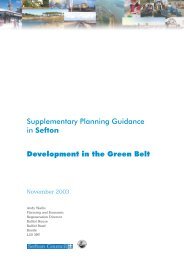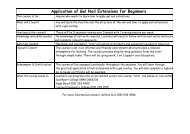The impact of sand extraction at Formby Point ... - Sefton Council
The impact of sand extraction at Formby Point ... - Sefton Council
The impact of sand extraction at Formby Point ... - Sefton Council
Create successful ePaper yourself
Turn your PDF publications into a flip-book with our unique Google optimized e-Paper software.
• Rapid, up-to-d<strong>at</strong>e assessment <strong>of</strong> the condition <strong>of</strong> the habit<strong>at</strong>s and species associ<strong>at</strong>ed<br />
with former <strong>sand</strong> <strong>extraction</strong> sites, noting any positive and neg<strong>at</strong>ive trends.<br />
3<br />
• Advise on management <strong>of</strong> existing sites, with reference to the management plans for<br />
Lifebo<strong>at</strong> Road, Ravenmeols Local N<strong>at</strong>ure Reserve and Cabin Hill N<strong>at</strong>ional N<strong>at</strong>ure<br />
Reserve.<br />
• Assess potential for future habit<strong>at</strong> maintenance, restor<strong>at</strong>ion and cre<strong>at</strong>ion <strong>at</strong> several<br />
scales – from small-scale and local (e.g. single slack) to large-scale (e.g. restor<strong>at</strong>ion<br />
plan for whole <strong>extraction</strong> site).<br />
• Comment on potential for positive habit<strong>at</strong> management, restor<strong>at</strong>ion or cre<strong>at</strong>ion for<br />
BAP habit<strong>at</strong>s and species, including N<strong>at</strong>terjack Toad, Sand Lizard, Common Lizard,<br />
Gre<strong>at</strong> Crested Newt, Northern Dune Tiger Beetle, Colletes Vernal Mining Bee,<br />
Grayling, Dark Green Fritillary and others.<br />
2. Ecological survey<br />
2.2. Methods<br />
Loc<strong>at</strong>ions <strong>of</strong> major <strong>sand</strong> quarries <strong>at</strong> Lifebo<strong>at</strong> Road, Ravenmeols and Cabin Hill, as<br />
defined by recent Lidar survey and aerial photographs taken in 1945, 1961 and 1979,<br />
were visited in early October 2007. Notes were made on habit<strong>at</strong>s and veget<strong>at</strong>ion, with<br />
particular reference to habit<strong>at</strong>s scheduled in the EU Habit<strong>at</strong>s Directive and<br />
regionally/n<strong>at</strong>ionally notable species, including those considered in the North Merseyside<br />
BAP. Changes over time were determined by reference to aerial photographs, N<strong>at</strong>ional<br />
Veget<strong>at</strong>ion Classific<strong>at</strong>ion (NVC) reports and maps, other reports, personal note-books<br />
and transparencies. Site Management Plans were examined in the context <strong>of</strong> habit<strong>at</strong> and<br />
species management and potential for future habit<strong>at</strong> restor<strong>at</strong>ion/cre<strong>at</strong>ion.<br />
2.3. Results<br />
2.3.1. Lifebo<strong>at</strong> Road<br />
All <strong>of</strong> this area is owned by <strong>Sefton</strong> Metropolitan Borough <strong>Council</strong>. As determined from<br />
the 1945 photographs, the main quarry site is bounded by pine woodland in the east,<br />
Lifebo<strong>at</strong> Road to the south, Wicks Lane p<strong>at</strong>h in the north and former Asparagus fields to<br />
the west. It is also inferred th<strong>at</strong> <strong>sand</strong> removal took place from frontal dunes to the north















